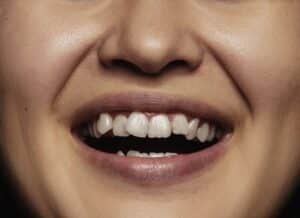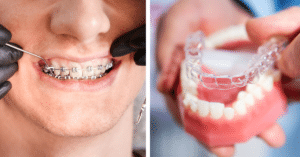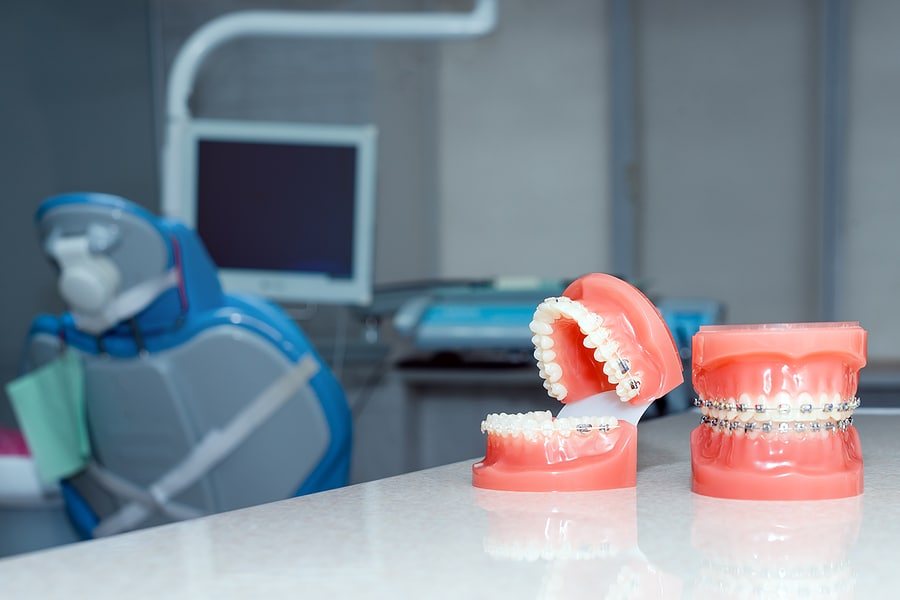If you’re concerned about your teeth being crooked or misaligned, chances are you need orthodontic treatment. Nine out of ten people have malocclusion, or slightly misaligned teeth, and 75% of us have issues with our wisdom teeth not being able to erupt properly. Thankfully, today’s treatments are more efficient and practical than ever. So, in the Invisalign vs. braces debate, which one suits you best?
Understanding Invisalign
Imagine achieving a straighter smile without the hassle of bulky metal wires and brackets. That’s the magic of Invisalign! But how does it work? This treatment employs a series of custom-made, transparent aligners that gently guide your teeth into place. These aligners are virtually invisible, meaning you can flash your smile with confidence at any moment during treatment.
BENEFITS OF INVISALIGN
- Discreetness: Invisalign aligners are virtually invisible, allowing you to straighten your teeth with confidence.
- Removability: Unlike traditional braces, Invisalign aligners can be easily removed for eating, brushing, and flossing, making oral hygiene routines simpler.
- Comfort: Invisalign aligners are made from smooth, comfortable plastic, minimizing irritation to your cheeks and gums.
- Convenience: With fewer office visits required for adjustments compared to braces, Invisalign offers greater convenience for busy lifestyles.
LIMITATIONS
- Not Suitable for Severe Orthodontic Issues: While effective for mild to moderate cases, Invisalign may not be suitable for severe orthodontic issues that require more extensive treatment.
- Requires Discipline in Wearing Aligners Consistently: To achieve optimal results, Invisalign aligners should be worn for 20–22 hours per day, requiring discipline and commitment from the wearer.
- Can Be More Expensive Than Traditional Braces: Invisalign treatment may come with a higher price tag compared to traditional braces, making it important to consider budget constraints when choosing between the two options.
Exploring Traditional Braces
Traditional braces consist of brackets bonded to the teeth and connected by archwires, which are adjusted periodically to gradually move the teeth into proper alignment. Elastic bands may also be used to exert additional pressure on specific teeth as needed.
BENEFITS OF BRACES
- Effectiveness for Complex Cases: Traditional braces are highly effective for correcting even the most severe orthodontic issues, including significant misalignment, overcrowding, and bite problems.
- Reliability: Once braces are applied, there’s no risk of misplacing or forgetting them, providing consistent and reliable treatment.
- Cost-Effectiveness: Traditional braces often come at a lower price point compared to alternative treatments, making them a more budget-friendly option for many patients.
LIMITATIONS
- Visibility: The metal brackets and wires of traditional braces are noticeable when smiling, which can impact self-confidence, especially for teenagers and adults.
- Discomfort During Adjustments: Periodic adjustments of traditional braces can cause temporary discomfort or soreness, particularly immediately after appointments.
- Dietary Restrictions: Certain foods and snacks, such as sticky candies or hard nuts, may need to be avoided to prevent damage to brace components.
In the Invisalign vs. braces debate, traditional braces may not offer the discreetness or convenience of Invisalign, but they remain a reliable and effective option for achieving a straighter smile, particularly for complex orthodontic cases.
Invisalign vs. Braces: Key Considerations When Choosing Between
A. Severity of Orthodontic Issues

During a consultation with an orthodontist, they’ll evaluate your case and recommend the most suitable treatment for achieving your desired results. Consulting with an orthodontic specialist ensures personalized care tailored to your specific needs and goals.
B. Lifestyle Factors
- Appearance During Treatment: Consider your preference for discreetness and how visible orthodontic appliances may impact your confidence and daily interactions.
- Ability to Comply with Maintenance and Care Requirements: Evaluate your commitment to wearing aligners consistently (for Invisalign) or adhering to dietary restrictions and oral hygiene practices (for braces).
- Dietary Habits: Examine your eating habits and determine if certain foods may be restricted or pose challenges during orthodontic treatment.
- Participation in Instruments or Sports: Assess whether involvement in activities such as playing musical instruments or participating in contact sports may influence your choice between Invisalign and braces due to comfort, safety, or practicality considerations.
C. Treatment Duration and Appointment Frequency
Invisalign treatment typically offers a more flexible schedule, with fewer in-office appointments required for adjustments compared to traditional braces. With Invisalign, you’ll receive sets of aligners to change at home every few weeks, reducing the need for frequent visits to the orthodontist. This can be particularly convenient for individuals with busy lifestyles or those who live far from their orthodontic provider’s office.
Conversely, traditional braces often require more frequent visits for adjustments, typically every 4-6 weeks, to ensure that the wires and brackets are properly maintained and teeth are progressing according to the treatment plan. This higher frequency of appointments may require more time off from work or school for patients and can be a factor to consider when choosing between the two treatment options.
D. Budget Considerations
- Cost of Treatment: Compare the overall cost of Invisalign treatment versus traditional braces, including initial expenses, follow-up appointments, and any potential additional fees.
- Insurance Coverage: Check with your dental insurance provider to determine coverage for orthodontic treatment and whether one option may be more financially advantageous.
- Available Financing Options: Explore payment plans or financing options offered by orthodontic practices to help manage the cost of treatment and make it more accessible.
Consulting an Expert
While choosing between Invisalign vs. braces based on your preference is the first step, gaining insights from seasoned orthodontists proficient in both treatments is invaluable. Through an assessment, a trusted orthodontist can shed light on various facets of orthodontic treatment, offering a comprehensive understanding for patients.
During appointments, they typically conduct the following examinations:
- Clinical Examination: The orthodontist performs a comprehensive visual inspection of the patient’s teeth, jaws, and facial structure. This examination helps identify visible signs of misalignment, such as overcrowding, spacing issues, or abnormal bite patterns.
- X-Ray Imaging: X-ray images, including panoramic or cephalometric radiographs, provide detailed views of the teeth, jaws, and surrounding structures. These images allow the orthodontist to assess the positioning of teeth, root structures, and bone density, aiding in the diagnosis of misalignment and treatment planning.
- Digital Impressions: Orthodontists may take impressions of the patient’s teeth or utilize digital scanning technology to create 3D models of the dental arches. These scans help visualize the current alignment of the teeth and predict the intended result.
- Functional Assessment: Orthodontists evaluate the functionality of the patient’s bite through bite analysis and jaw movement assessments. This involves examining how the upper and lower teeth occlude (bite together) and assessing jaw alignment during various movements, such as chewing or speaking.
Access to Comprehensive Orthodontic Care

With our extensive experience and expertise in both traditional braces and clear aligner treatments, our team is equipped to provide top-notch care regardless of the option you choose. Dr. Michael Skrobola, Dr. Jonathan B. Schlosser, and Dr. Mike Skrobola have been recognized as the BEST ORTHODONTISTS in the Hudson Valley.
From the initial consultation to the final adjustments, our focus remains on delivering exceptional results and ensuring your comfort and satisfaction throughout your orthodontic journey. Trust us to help you achieve the smile of your dreams, knowing that you have access to the latest advancements and personalized care every step of the way.
Book an Appointment
To discover your Invisalign vs. braces and other appliance options or start an orthodontic treatment, schedule a FREE initial consultation with Bracesetters Orthodontics. Our offices are located in Middletown, Newburgh, Monroe, and Monticello in New York.



